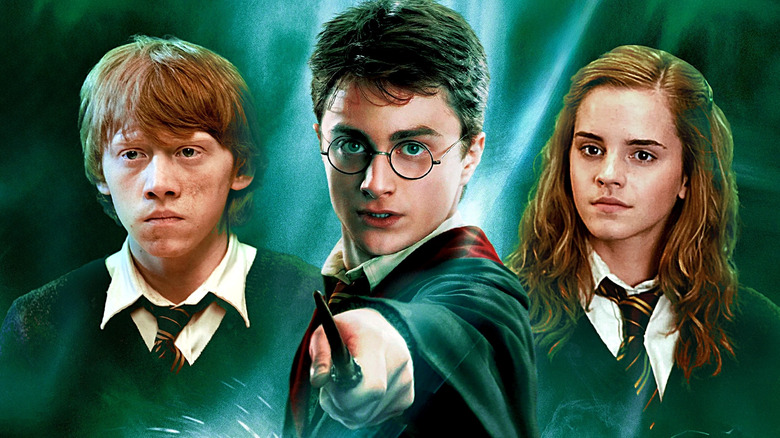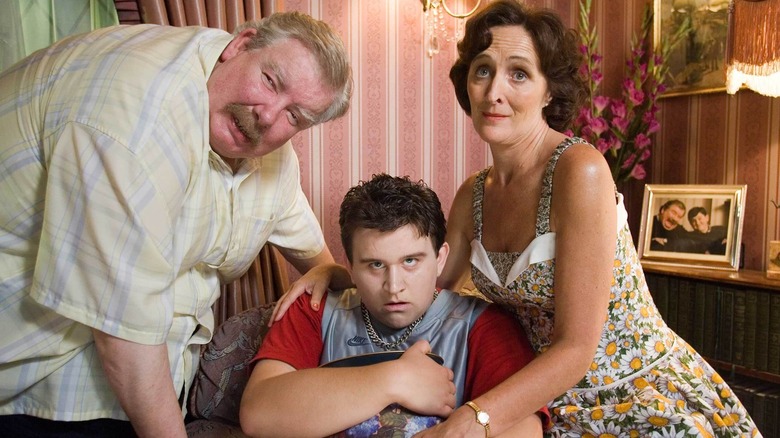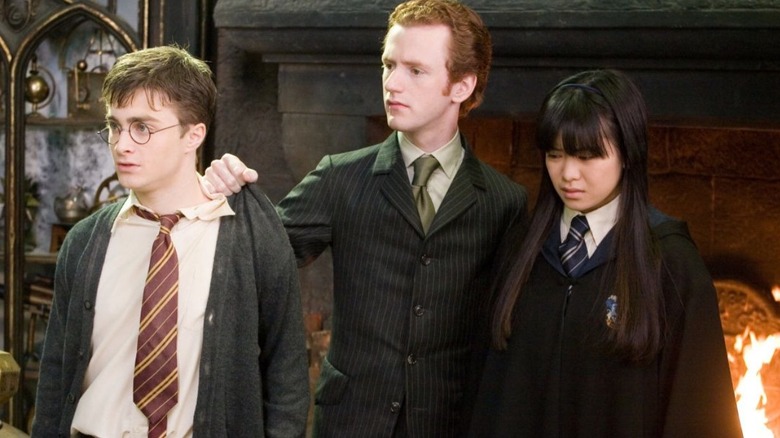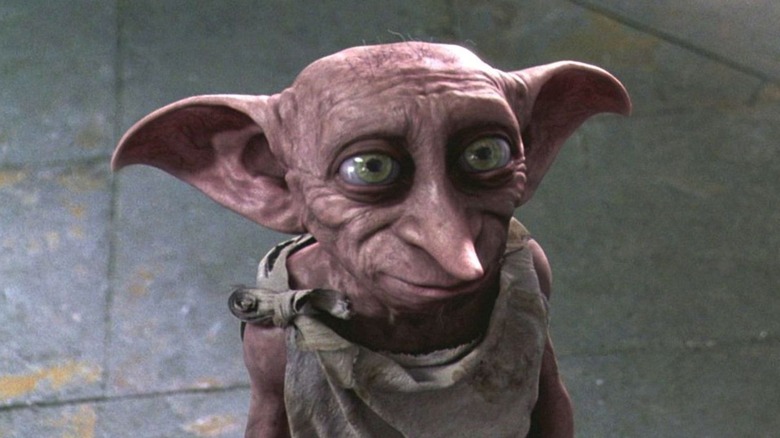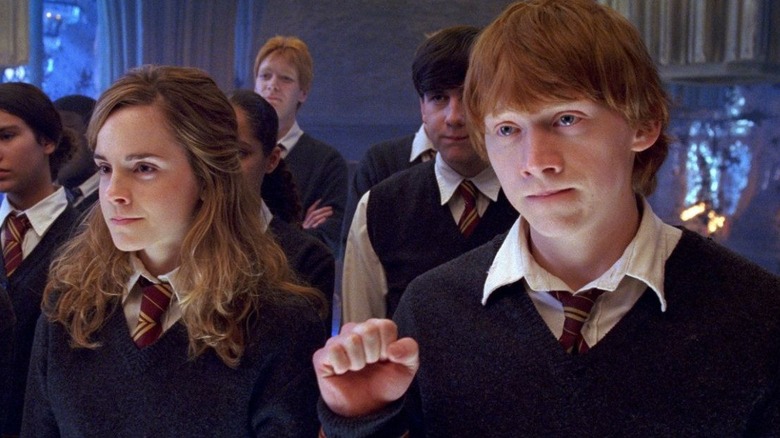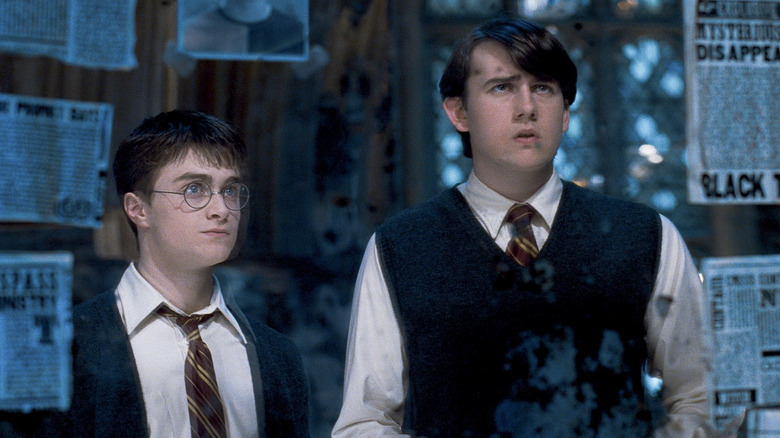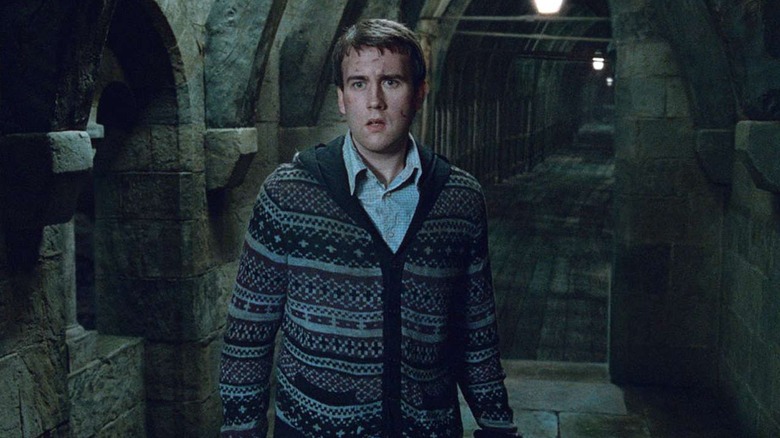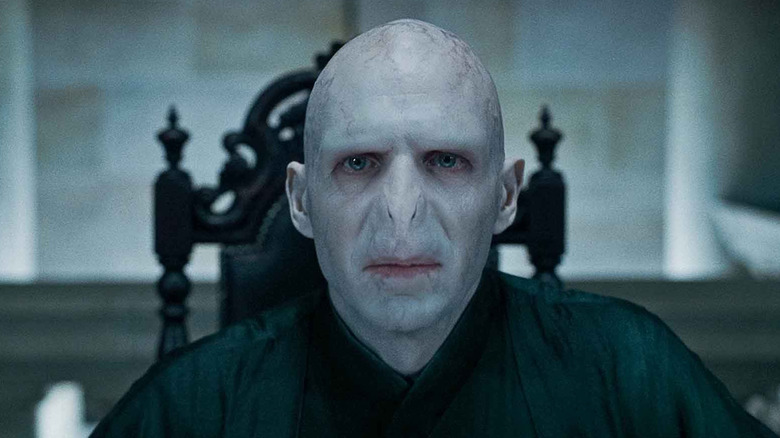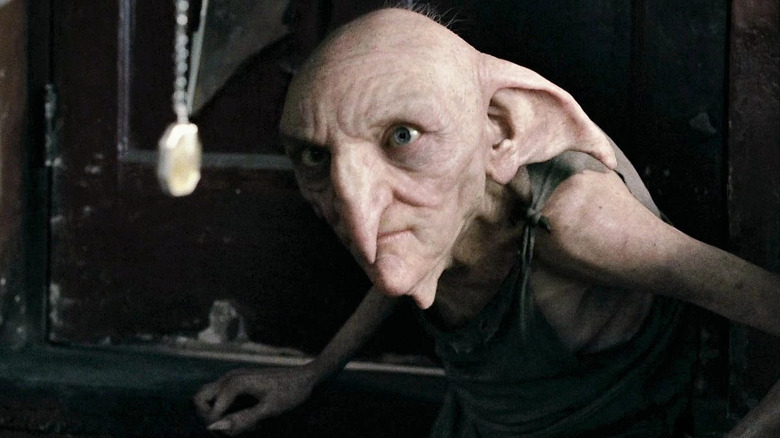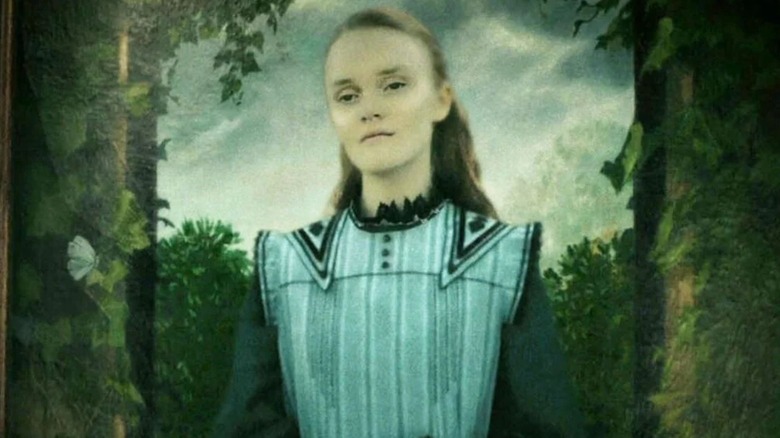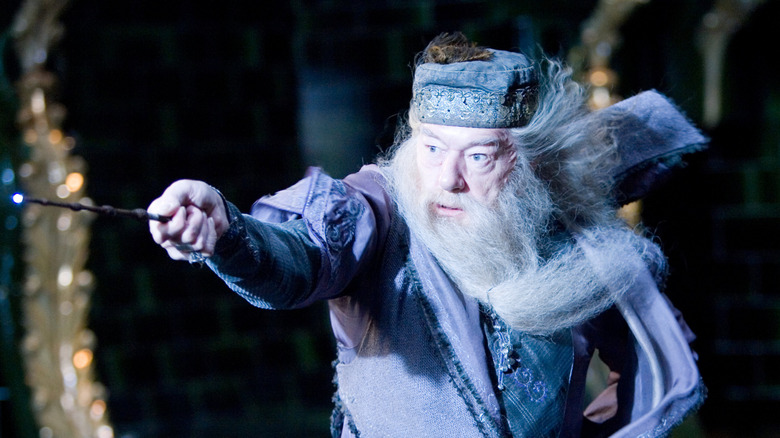12 Cut Harry Potter Movie Subplots That Should Be In The HBO Series
Nearly 15 years after the conclusion of the "Harry Potter" film franchise, and almost 20 years since the release of J.K. Rowling's final novel, "Harry Potter and the Deathly Hallows," Warner Bros. is teaming up with HBO to produce an all-new TV series based on the beloved books. We've already met many members of the cast, and while details remain scarce, it's safe to assume the show will stick more closely to the source material, perhaps even expanding on moments the films had to omit.
Yes, the movies are genuine classics — well, most of them, anyway — and the various directors and writers did their best to adapt Rowling's massive texts into feature-length films suitable for general audiences. But that meant many important characters and plot threads were either glossed over or cut entirely.
With 8–10 hours at their disposal per season, the "Harry Potter" TV series showrunners should have more than enough time to present faithful adaptations of the books and include signature moments like the 12 listed below. Without further ado, here are 12 cut "Harry Potter" subplots that should finally get their due in the upcoming HBO series.
Peeves the Poltergeist
The first thing many "Harry Potter" book fans notice about the films is the complete absence of Peeves the Poltergeist — and, frankly, most of the ghosts. Even Nearly Headless Nick (played by John Cleese) disappears after the first two films, which robs Hogwarts of some of its quirky, otherworldly charm.
As for Peeves, in the books, he's a mischievous spirit and a constant thorn in the side of Hogwarts staff. But he also occasionally aligns with the students, most notably during Fred and George's legendary escape from Dolores Umbridge in "Harry Potter and the Order of the Phoenix," when he gleefully adds to the chaos. He even fights in the Battle of Hogwarts, attacking Death Eaters with wild abandon and closing the saga with a triumphant victory song in Harry's honor.
Ultimately, Peeves is more than comic relief; he's as essential to the spirit of Hogwarts as Nearly Headless Nick and Moaning Myrtle. A magical force that even powerful wizards can't control, he fights for the right side when it matters most. Here's hoping the HBO series gives this chaotic icon the spotlight he deserves.
Dursley's Evolution
"Harry Potter and the Sorcerer's Stone" begins with the Boy Who Lived (Danielle Radcliffe) residing with his Aunt Petunia (Fiona Shaw), Uncle Vernon (Richard Griffiths), and cousin Dudley (Harry Melling), a trio of despicable Muggles who detest magic enough to hide Harry's true lineage. Throughout the book, readers make frequent stops at the Dursleys' home on Number 4, Privet Drive in Little Whinging, Surrey, England, and watch as their testy relationship with Harry evolves into something resembling harmony by their final appearance in "Harry Potter and the Deathly Hallows."
By contrast, the films practically shout "Evanesco!" and place the vanishing spell on these crazy Muggles from "Harry Potter and the Goblet of Fire" and on, relegating them to bite-sized cameos completely devoid of substance. Consequently, we lose much of Harry's character development, as his resiliency (or lack thereof) in the face of their awful parenting allows us to see where he is emotionally at the start of each story. We also miss out on the Dursleys' true purpose, as the blood-based protection spell surrounding their house, conjured by Lily Potter's sacrifice — so long as Harry called Privet Drive his home — is barely touched on in the film; as is Aunt Petunia's relationship with her sister. The "Deathly Hallows" novel even has a scene in which Dudley makes amends with Harry, a powerful bit of closure that didn't make it into the two part movie adaptation for whatever reason.
Percy Weasley
Book fans know all about Percy Weasley — the wayward son of Arthur (Mark Williams) and Molly (Julie Walters) — who takes a detour to the Dark Side before undergoing a significant character transformation by the time of the Battle of Hogwarts in "Harry Potter and the Deathly Hallows." The character appears in nearly all of the films, but primarily in a non-essential, non-speaking capacity, portrayed by actor Chris Rankin. We first see him as a snooty prefect in "Sorcerer's Stone," then working alongside the Minister of Magic (Robert Hardy) in "Order of the Phoenix," and finally standing beside his family during the fight against Voldemort (Ralph Fiennes). But the films provide virtually no context for his character. Moviegoers likely missed him completely — which is a shame, because Percy's journey highlights how the war with Voldemort fractures families into two sides: those who believe Harry, and those who side with the Ministry of Magic. It's an apt allegory for our own politically divided times.
Moreover, Percy's tearful reunion with his father in "Deathly Hallows" adds emotional gravitas to an already devastating finale — layered with irony, as Arthur regains a son at the very moment he loses Fred (James Phelps) during the battle. Hopefully, the upcoming TV series finds room for Percy, because his evolution from pompous self-promoter to humble member of the Weasley family adds a crucial dose of heart to the story.
S.P.E.W.
Another fun subplot the films nixed is Hermione's efforts to advocate for the rights of house-elves by creating the Society for the Promotion of Elfish Welfare, or S.P.E.W. in "Harry Potter and the Goblet of Fire." While mostly played for laughs, mainly due to the fact that many of the elves staunchly oppose the movement, the organization adds more weight to Hermione's character and a little more nuance to supporting players like Kreacher and Dobby.
Dobby enjoys a significant role throughout the novels. Following his appearance in "Harry Potter and the Chamber of Secrets," during which Harry frees him from the Malfoys, Dobby continues to aid our heroes in their quest to vanquish the Dark Lord. He introduces Harry to the Room of Requirement in "Order of the Phoenix," and lands a job in the Hogwarts kitchen, where he contends with other elves who disagree with his new way of life. By contrast, Dobby's role in the films is significantly diminished after "Chamber of Secrets." He arrives to save the day in "Deathly Hallows – Part 1," but his sudden appearance feels more random than organic.
S.P.E.W. also indirectly impacts Kreacher, a disgruntled house-elf who plays a key role in the overarching plot and only agrees to help our heroes following Hermione's respectful treatment of elves. Again, it's not a crucial subplot, but S.P.E.W. helps smooth over pivotal plot beats and offers extra emotional and thematic depth to the story.
Marauders Details
Remember in "Harry Potter and the Prisoner of Azkaban" when Fred and George Weasley gift Harry the Marauder's Map, a magical device that shows every detail of Hogwarts right down to Dumbledore's location? Yeah, it's a pretty nifty item that, for whatever reason, is entirely left unexplained in the films. Moviegoers who hadn't read the books likely chalked up the map to another plot device and disregarded its significance, which is a shame because there's so much more to this particular story.
The Marauders, you see, consist of Remus Lupin (Moony), Peter Pettigrew (Wormtail), Sirius Black (Padfoot), and James Potter (Prongs), a pack of loyal, mischievous friends who were constantly up to no good during their seven years at Hogwarts. Upon learning that Lupin was a werewolf, the other three became Animagi to support him. Hence, Sirius and Peter transform into a black dog and a rat in the films, respectively. James, for his part, transforms into a stag, reflecting his and Harry's Patronus.
Throughout the series, we learn a great deal about the Marauders, particularly their interactions with Severus Snape, a boy they often bully. Snape was no saint, but the complicated relationship between James and Severus is far more interesting and layered in the novels than it is in the films. Here's to hoping the TV series follows the books and supplies a more nuanced version of the Marauders and their dealings with Snape.
Ron and Hermione as Prefects
"Harry Potter and the Order of the Phoenix" spends a great deal of time finding ways to separate Harry from his friends, leaving him jaded and angry a few months after watching Cedric Diggory (Robert Pattinson) perish at the hands of Voldemort. Sure, the film adaptation touches on Harry's isolation, but only fleetingly; we never fully see how alone he feels before the formation of Dumbledore's Army.
A crucial detail omitted that may have helped in this regard is the role of Ron and Hermione as prefects. For those unaware, a prefect is a leadership role given to specific students by the school staff, i.e., Dumbledore. Following his encounter with Voldemort, Harry unquestionably fits the bill. In a shocking twist, however, Ron gets the gig alongside Hermione, leaving Harry in the dust. Moreover, their new roles arrive with new assignments and responsibilities that drive them away from Harry, who grows even more bitter towards his friends and Dumbledore as a result. It's a rare occasion when Harry allows negative emotions, such as jealousy, to get the better of him, which strengthens the psychic connection between him and Voldemort.
This subplot also strengthens Ron, allowing him to gain a little more self-confidence and self-respect — crucial traits that aid in the battle to come. In the films, Ron is regrettably reduced to gawking at Harry and never afforded the same spotlights as his two mates. Hopefully, the TV series will give him more chances to shine.
St. Mungo's Hospital Visit
Not so much a subplot as a crucial scene that adds more context to an existing subplot, Harry, Ron, and Hermione's visit to St. Mungo's is a bizarre bit to cut from "Harry Potter and the Order of the Phoenix." The film tells us about Neville Longbottom's parents, how they were tortured into insanity by Bellatrix Lestrange (Helena Bonham Carter), and reside at St. Mungo's — credit to actor Matthew Lewis for infusing the moment with pathos.
However, in the books, our trio of heroes bumps into Neville while visiting Arthur after Voldemort's snake Nagini attacks him at the Department of Mysteries, and they witness firsthand the state of Neville's parents — they don't even recognize the poor kid. Neville, clearly embarrassed, does his best to deal with the situation, but he is clearly uncomfortable with his friends discovering the truth about his family. It's a critical moment, if only because it demonstrates how the war with Voldemort impacted the entire Wizarding World beyond the Potter family and what this magical universe stands to lose should they fail. It also sets up Neville's long-standing grudge with Bellatrix, a subplot that J.K. Rowling curiously sidesteps in "Deathly Hallows."
Gilderoy Lockhart is also on hand at St. Mungo's, still recovering from the memory wipe he accidentally performed on himself in "Chamber of Secrets." How much fun would it have been to see Kenneth Branagh reprise his role in this scene?
The Second Chosen One: Neville Longbottom
Sticking with Neville, there's an even deeper aspect to his story that the films omit — he's also the Chosen One. Well, kind of. See, in "Harry Potter and the Order of the Phoenix," Dumbledore explains the all-important prophecy thusly: "The one with the power to vanquish the Dark Lord approaches... born to those who have thrice defied him, born as the seventh month dies..." Harry and Neville fit this description, as the former was born on July 31 and the latter on July 30; their parents were members of the Order of the Phoenix and had defied Voldemort three times.
Why didn't Voldemort target Neville? As Dumbledore explains, he saw Harry as the greater threat because, well, he was a half-breed, like he was: "He chose the boy he thought most likely to be a danger to him. And notice this, Harry: he chose, not the pure-blood (Neville), but the half-blood, like himself," Dumbledore said. So, by trying to stop the prophecy relating to his downfall, Voldemort's decision to pursue Harry (and kill his parents) effectively set it in motion, which aligns with the grander themes about how our choices, as Dumbledore puts it, "show what we truly are, far more than our abilities."
More Young Voldemort
A pivotal plot point in "Harry Potter and the Half-Blood Prince" revolves around Harry and Dumbledore's investigation into Voldemort's past. Our heroes need to learn as much as possible about the Dark Lord to understand how to defeat him, a path that leads them to discover the Horcruxes. During their investigation, Harry sees the events that transformed a young Tom Riddle into the terrifying Voldemort, many of which mirror moments from his own life. Of course, the already lengthy film adaptation omitted many details from these book excerpts, focusing only on scenes that directly serve the plot.
However, on TV, the showrunners can likely afford to spend more time in Voldemort's past and further expand his backstory for general audiences. In the book, for example, we are privy to the whole story of Voldemort's mother, Merope Gaunt, her troubled past, and her complicated relationship with Tom Riddle Sr. We also learn about Voldemort's bloodline, including specifics about Marvolo's ring, and watch as a young Tom Riddle uses manipulation to ascend in social status at Hogwarts, where he slowly collects his Death Eaters and loyal followers. Finally, J.K. Rowling details the importance of each Horcrux and how they came into Voldemort's possession, increasing the significance of each artifact — interesting tidbits we'd love to see in the HBO series.
Kreacher's Purpose
Following their investigation into Voldemort's past, Harry and Dumbledore set out to destroy the Horcruxes in "Harry Potter and the Half-Blood Prince." During the intense climax, the pair reach a hidden location that requires them to commandeer a boat across a lake. The twist? The boat only allows one person inside at a time. However, the magic overlooks Harry because he is not considered a full magical threat. They retrieve the Horcrux — or so they think — only to discover a note from someone identified only as R.A.B., claiming to have already taken the real artifact.
Enter Kreacher, who, as it turns out, is far more vital to the plot than initially believed. The films only briefly touch on Kreacher's significance and omit a key detail — that Regulus Black (aka R.A.B., Kreacher's former master) used Kreacher to retrieve the Horcrux. Regulus ordered Kreacher to accompany Voldemort to the cave, and the Dark Lord used the house-elf to test the magical defenses, including the potion in the basin designed to incapacitate whoever drank it. Satisfied with the trap, Voldemort left Kreacher to die — but the elf managed to Apparate back home and recount what had happened. Enraged, Regulus returned to the cave, drank the potion himself, and ordered Kreacher to take the real Horcrux and destroy it.
That's a lot of information to include in a single film — but it would make a terrific episode of TV. Hint, hint.
Ariana Dumbledore
In "Harry Potter and the Deathly Hallows," Harry learns more about Dumbledore's past and uncovers a horrible tragedy revolving around the headmaster's sister, Ariana. Now, in "Deathly Hallows – Part 2," Dumbledore's brother, Aberforth (Ciarán Hinds), hints at this event while gazing at a painting of the young woman but doesn't provide the whole story. J.K. Rowling and the filmmakers were likely going to reveal Ariana's fate in the "Fantastic Beasts and Where to Find Them" series, but that franchise unfortunately sputtered to a halt before the conclusion of its story.
Curious viewers must turn to Rowling's text — or maybe the upcoming HBO series — to assemble the pieces. The gist is that Dumbledore's sister, Ariana, was attacked by Muggles, an event that left her emotionally and magically unstable. Dumbledore's father, Percival, attacks the Muggles and is sent to Azkaban, where he dies. Meanwhile, Dumbledore's mother, Kendra, moves the family to Godric's Hollow, where Ariana accidentally kills her during one of her episodes. Outraged by this family tragedy, Dumbledore then joins forces with Gellert Grindelwald to subjugate Muggles, something Aberforth vehemently opposes. The trio eventually comes to blows, and Ariana dies via a stray magical blast in the ensuing battle.
This personal tragedy profoundly reshaped Dumbledore's entire worldview, fueling his guilt and humility and ultimately leading to his opposition to the pursuit of power.
Dumbledore and Grindelwald
Even more interesting is Dumbledore's climactic duel with Grindelwald. The films only briefly touch on this episode — notably when Ron (Rupert Grint) reads about it on the back of a Chocolate Frog card in "Harry Potter and the Sorcerer's Stone." We also catch glimpses of a young (Jamie Campbell Bower) and old (Michael Byrne) Grindelwald in "Deathly Hallows," albeit with little context. And while the "Fantastic Beasts" series features the character (first played by Johnny Depp, and later Mads Mikkelsen) alongside a young Dumbledore (Jude Law), the franchise didn't survive long enough to depict their iconic battle.
After Ariana's death, Dumbledore's life took a dramatic turn. He severed ties with Grindelwald, accepted a teaching position at Hogwarts, ascended to Headmaster, and became the wise and revered wizard we know.
Concurrently, Grindelwald continued his rise to power, attaining the Elder Wand and unleashing a reign of terror across Europe in the 1940s. Dumbledore initially avoided the inevitable confrontation, haunted by the fear that it was his spell that killed his sister. But at last, he faced his former friend (and lover, according to J.K. Rowling) in what would become one of the most legendary duels in wizarding history.
Out of everything on this list, this is the moment we must see brought to life. HBO, don't deprive us of this monumental showdown!
